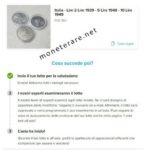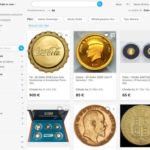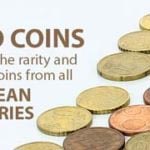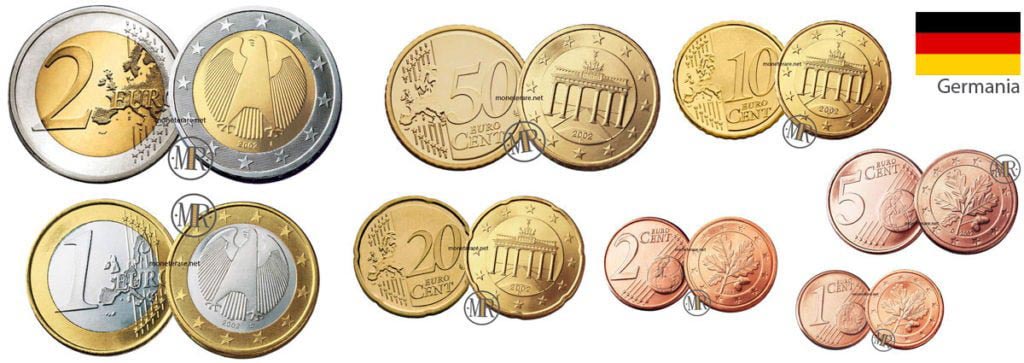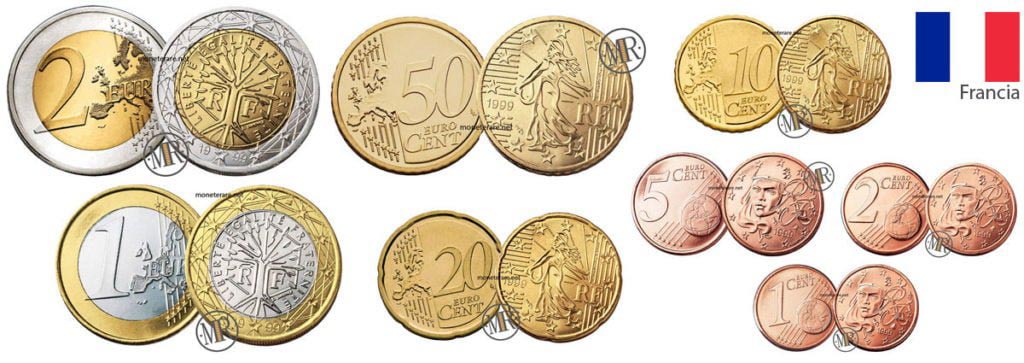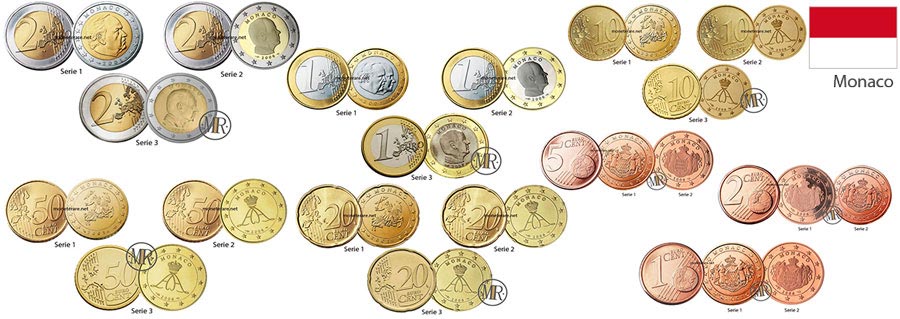
In this page we will see the interesting Monaco Euro Coins, all the denominations and all the values both for every denomination and for every year. So be careful because the European coins of the Principality of Monaco have very high prices and are much sought after by collectors.
Introduction
The Principality of Monaco is a small state whose entire territory is included in that of France. It must be said, however, that this small state has been totally independent since 1297.
Although the Principality of Monaco is independent, it has always used the same currency as France, thanks to the monetary agreements made with France. Only in 1837 did it begin to produce its own currency called the Monegasque Franc.
The exchange rate between the Munich and French currencies has always been at parity and both currencies have always circulated freely in both countries.
When France joined the European Union, precisely because of these agreements, the Principality of Monaco, which is not part of the EU, was also granted the right to use the Euro and to mint its own coins.
It is important to specify that the Monaco Euro Coins are extremely rare and for this reason particularly sought after by collectors.
All Monegasque Euro coins are minted by the French Mint of Pessac.
But let’s see in detail all the coins and the characteristics that distinguish them.
1 Cent Monaco Euro Coins
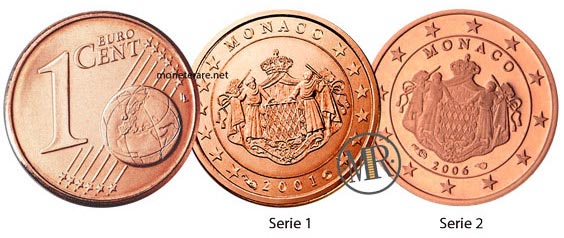
The very first coin we are going to analyse is, of course, the 1 Cent Monaco Euro Coins. It is important to underline that there are two versions of this same currency. The first one dates back to the period from 2001 to 2005, while the second one concerns the years from 2006 onwards. For both, the author is Robert Cochet.
The first series presents the coat of arms of the Principality of Monaco placed in the center of the obverse. All around the 12 five-pointed stars representing the European States with the word Monaco at the top.
At the bottom there is the thousandth of mint and the symbol of Mint.
The second series is very similar and always has the symbol of the Principality of Monaco on the obverse, while at the bottom the thousandth of minting surrounded on the right and left by the symbol of the Mint and the symbol of the Director of the Mint. Above: the word Monaco.
The whole is surrounded by 12 five-pointed stars, symbol of the European States.
As far as the reverse is concerned, all the coins are the same as those of the other European countries.
But let’s see the technical specifications.
Specification of the 1 Cent Coin of Principality of Monaco
- Materials : The material used is an alloy of steel plated with copper (steel 94.35% – copper 5.65%)
- Thickness: The thickness is 1.67 mm
- Weight: The weight is 2.30 g
- Diameter: The diameter is 16.25 mm
- Outline: The contour is completely smooth
- Engraver: Robert Cochet
Value and Circulation of the 1 Cent Coin of Principality of Monaco
Hard to believe, but the 1 cent Monaco Euro Coins 2006 has a value of more than 45 euros in Brilliant Uncirculated. It means that it has a value of 4500 times its face value!
2 Cent Monaco Euro Coins
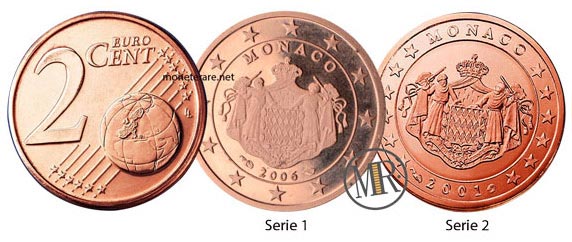
Let us then move on to the next coin, the 2 cent Monaco Euro Coins. Also in this case we are talking about two different versions that go from 2001 to 2005 for the first under Prince Rainier III and the second from 2006 onwards under Prince Albert II. The author is always Robert Cochet.
As far as the First Series of the Obverse face is concerned, it presents the representation of the coat of arms of the Principality of Monaco. It is surrounded by 12 five-pointed stars and at the top by the word MONACO.
Below is the thousandth of a coin surrounded by the symbol of the Mint and that of the Director of the Mint.
As far as the second series of the straight coin is concerned, there is always the coat of arms of the Principality of Monaco with the inscription MONACO at the top.
Below is the thousandth of a coin surrounded by the symbol of the Mint and that of the Director of the Mint.
Everything is surrounded, after a dividing line, by 12 five-pointed stars that represented the States of the European Union.
On the other hand, we are talking about the same face as the other European states.
But let’s see the technical characteristics together.
Specification of the 2 Cents Coin of Principality of Monaco
- Materials: The material used is always steel plated with copper (steel 94.35% – copper 5.65%)
- Thickness: The thickness is always 1.67 mm
- Weight: Weight increases to 3.06 g
- Diameter: The diameter also increases to 18.75 mm
- Outline: The contour is characterized by an incused horizontal thread
- Engraver: Robert Cochet
Value and Circulation of the 2 Cent Coin of Principality of Monaco
The most quoted 2 cent Euro coin of the Principality of Monaco is the 2005 one, which is worth more than 39 euro.
5 Cents Monaco Euro Coins
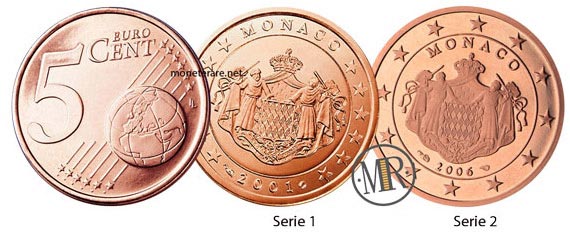
Arriviamo dunque alla moneta da 5 Centesimi di Euro Monaco. Parliamo ancora una volta di due versioni realizzate sotto due Principi differenti. Nello specifico la prima sotto il Principe Ranieri III e la seconda sotto il Principe Alberto II.
L’autore è sempre Robert Cochet.
La Prima serie della moneta (2001- 2005) al Dritto presenta lo stemma del Principato di Monaco collocato al centro. Intorno allo stemma sono inserite 12 stelle a cinque punte e in alto capeggia la scritta MONACO.
In basso è possibile trovare invece il millesimo di conio, il simbolo di Zecca e quello del Direttore di Zecca.
Per quanto riguarda la Seconda serie della moneta (dal 2006 in poi) possiamo trovare delle piccole differente. Al Dritto è sempre presente il simbolo del Principato di Monaco con in alto la scritta Monaco ed in basso millesimo di conio, simbolo di Zecca e simbolo del Direttore.
Il tutto è circondato da una linea sottile e da un cerchio di 12 stelle che rappresentano gli Stati dell’Unione Europea.
Per quanto riguarda il Verso entrambe le monete presentano la stessa facciata di qualsiasi altra moneta europea.
Ma vediamo insieme le caratteristiche tecniche.
Specification of the 5 Cents Coin of Principality of Monaco
- Materiali: Il materiale utilizzato anche in questo caso è una lega di acciaio placcato con rame (acciaio 94,35% – rame 5,65%)
- Spessore: Lo spessore è ancora di 1,67 mm
- Peso: Il peso aumenta ancora arrivando a 3,92 g
- Diametro: Stesso discorso per il diametro che arriva a 21,25 mm
- Contorno: Il contorno è completamente liscio
- Incisore: Robert Cochet
Value and Circulation of the 5 Cent Monaco Euro Coins
10 Cents Monaco Euro Coins
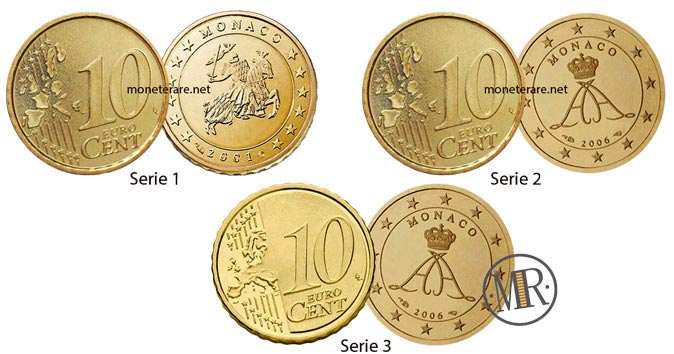
Vediamo ora la moneta da 10 Centesimi di Euro Monaco. Anche in questo caso si parla di più versioni separate anche se le differenze questa volta sono davvero nette e marcate. Gli autori sono per la prima Nicolas Cozon e Roger Bernard Baron mentre per la seconda e la terza il solo Cozon.
Al Dritto la Prima serie della moneta (2001 – 2005) presenta al centro un cavaliere sigillo della famiglia Grimaldi. Tutto intorno le 12 stelle a cinque punte che rappresentano gli Stati europei ed in alto la scritta Monaco.
In basso invece c’è il millesimo di conio accompagnato da simbolo di Zecca e simbolo del Direttore di Zecca.
La Seconda e la Terza serie della moneta raffigura nel Dritto, al centro, il monogramma del Principe Alberto II succeduto al padre il Principe Ranieri III dopo la sua morte nel 2005.
In alto la scritta MONACO mentre in basso il millesimo di conio circondato dai simboli di Zecca e dal simbolo del Direttore di Zecca.
Al Verso tutte le serie di monete sono identiche alle altre monete da 10 Centesimi europee. La Prima e la Seconda serie hanno infatti la mappa dei Paesi Europei separati tra di loro, la Terza serie invece utilizza la nuova versione entrata in vigore nel 2007 con l’Euro Zona unita e non più con i paesi separati.
Vediamo subito le peculiarità tecniche.
Specification of the 10 Cents Coin of Principality of Monaco
- Materiali: Il materiale utilizzato è il Nordic Gold costituito da rame 89%, zinco 5%, alluminio 5% e stagno 1%
- Spessore: Lo spessore è di 1,93 mm
- Peso: Il peso è di 4,10 g
- Diametro: Il diametro è di 19,75 mm
- Contorno: Il contorno è rigato con zigrinatura spessa
- Incisore: Nicolas Cozon/Roger Bernard Baron per la prima e Nicolas Cozon per seconda e terza
Value and Circulation of the 10 Cent Monaco Euro Coins
A questa serie appartengono i 10 centesimi Monaco più quotati. Si tratta dei 10 centesimi del Principato anno 2006 dal valore di 34 euro.
20 Cents Monaco Euro Coins
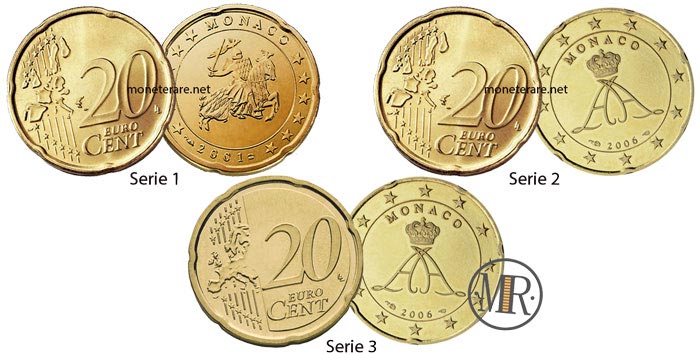
Eccoci giunti alla moneta da 20 Centesimi di Monaco. Parliamo anche per questa moneta di tre versioni. La prima che va dal 2001 al 2005 in onore del Principe Ranieri III, la seconda dal 2006 per il Principe Alberto II e la terza nel 2009 sempre per il Principe Alberto II.
Come per la moneta precedente anche in questo caso gli autori sono per la prima Nicolas Cozon e Roger Bernard Baron mentre per la seconda e la terza il solo Cozon.
Per quanto riguarda la Prima serie della moneta questa presenta al centro. nel Dritto, la raffigurazione di un cavaliere simbolo della famiglia Grimaldi. Intorno sono inserite le 12 stelle a cinque punte sopra le quali c’è la scritta MONACO.
In basso sono invece presenti il millesimo di conio con il simbolo di Zecca e quello del Direttore di Zecca.
La Seconda serie della moneta presenta invece, sempre al Dritto, il monogramma del Principe Alberto II. In alto c’è la scritta MONACO mentre in basso sono presenti il millesimo di conio e il simbolo di zecca con quello del Direttore di Zecca.
Tutto intorno ci sono le 12 stelle a cinque punte che rappresentano gli Stati europei.
Per il Verso troviamo invece la stessa faccia delle altre monete da 20 Centesimi. Per quanto riguarda la Prima e la Seconda serie viene utilizzata la mappa dei Paesi dell’Eurozona tutti separati tra di loro. Invece per la Terza serie, emessa nel 2009, viene utilizzata la nuova versione della mappa che raffigura l’Euro Zona unita e non più con tutti paesi separati.
Vediamo subito le caratteristiche tecniche.
Specification of the 20 Cents Coin of Principality of Monaco
- Materiali: Anche in questo caso il materiale è il Nordic Gold caratterizzato da rame 89%, zinco 5%, alluminio 5% e stagno 1%
- Spessore: Lo spessore è di 2,20 mm
- Peso: Il peso è di 5,75 g
- Diametro: Il diametro è di 22,25 mm
- Contorno: Il contorno è una godronatura larga
- Incisore: Nicolas Cozon/Roger Bernard Baron per la prima e Nicolas Cozon per seconda e terza
Value and Circulation of the 20 Cents Coin of Principality of Monaco
50 Cents Monaco Euro Coins
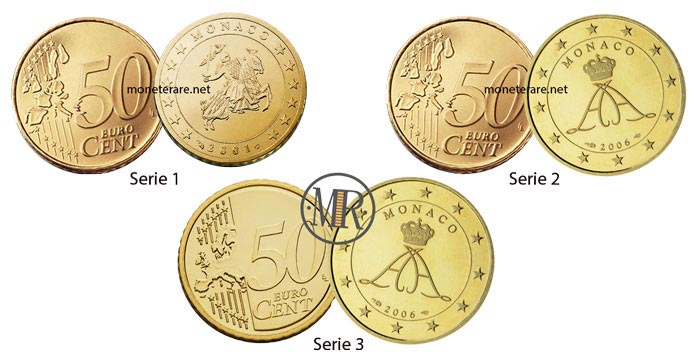
The next coin to be analysed is the 50 cents Monaco Euro Coins. Specifically, there are two versions also for this coin. The first one dates back to the years 2001 to 2005, the second one to 2006 and the third one to 2009 with the modified reverse.
The authors are Nicolas Cozon and Roger Bernard Baron for the first and only Nicolas Cozon for the second and third versions.
The first version of the coin on the obverse side, in the centre, depicts a knight, the seal of the Grimaldi family. All around are the 12 five-pointed stars with the inscription MONACO at the top.
At the bottom there is the thousandth mint in the middle and on both sides the symbol of the Mint and that of the Director of the Mint.
As for the Second series of 2006 and the Third series of 2009, the monogram of Prince Albert II, who succeeded his father Prince Rainier III after his death on April 6, 2005, is included in the obverse.
Above is the word MONACO and below the thousandth of minting with the symbol of the Mint and that of the Director of the Mint on the sides.
On the reverse, there are two versions of the Common Face. In fact, the first and second series have a map of the countries of the Euro Zone separated. For the third series of 2009, instead, the new version of the Common Face was used, which represented the Euro Zone all united and with the countries no longer separated from each other.
Let’s discover together the technical specificities.
Specification of the 50 Cents Coin of Principality of Monaco
- Materials: Once again the material used is the Nordic Gold consisting of 89% copper, 5% zinc, 5% aluminum and 1% tin
- Thickness: Thickness increases to 2.38 mm
- Weight: Weight also increases significantly to 7.80 g
- Diameter: The diameter is 24.25 mm
- Outline: The contour is grooved with thick knurling.
- Engraver: Nicolas Cozon/Roger Bernard Baron for the first and Nicolas Cozon for the second and third.
Value and Circulation of the 50 Cent Monaco Euro Coins
Amazing is the value that the 50 cents of the Principality can reach. For example, the Monégasque 50 cents Monaco Euro Coins of 2009 are quoted at 33 euro and those of 2006 over 39 €!
1 Euro Monaco
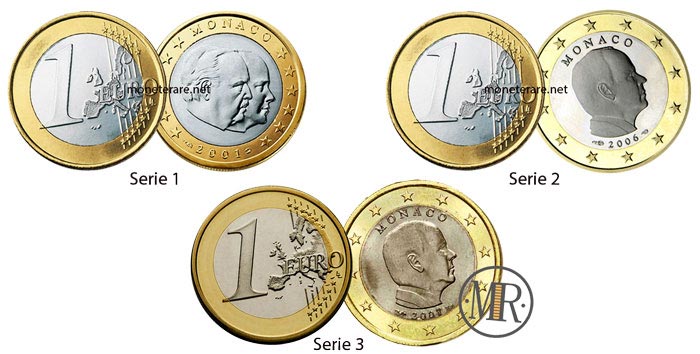
We then arrive at the 1 Euro Monaco coin, the second to last in this collection. In this case, too, we are talking about three versions made between 2001 and 2005 for the first one, in 2006 the second one and in 2009 the third one.
The authors are in this case Nicolas Cozon and Henri Thiebaud for the first and Sabrina Luoni for the second and third.
The first series of the coin depicts Prince Rainier III and his son Prince Albert II side by side. All around are engraved the 12 five-pointed stars representing the European states.
Above is the word MONACO and below the thousandth of minting surrounded by the symbol of the Mint and that of the Director of the Mint.
As far as the second and third series of the coin are concerned, only the face of Prince Albert II facing to the right is present. Above always the word MONACO while below the thousandth of minting and the symbol of Mint with that of the Director of Mint.
The whole thing is of course surrounded by the 12 five-pointed stars.
There is also a variant of this coin without the Mint symbols dating from 2007. In total there are about 3000 pieces.
As far as the reverse is concerned, this is identical to that of the other 1 euro coins. The first and second series use the same Common Face, the one with the map of the countries of the Euro Zone with the marked borders. Instead for the Third series, issued in 2009, is used the new version of the map depicting the Eurozone united and with countries without any graphic border.
But let’s see the specifications of this coin.
Specification of the 1 Euro Coin of Principality of Monaco
- Materials: In this case we are talking about a double material. The outer part is nickel-brass (copper 75% – zinc 20% – nickel 5%) while the inner part is copper-nickel (copper 75% – nickel 25%).
- Thickness: The thickness decreases to 2.33 mm
- Weight: Even the weight decreases slightly to 7.50 g
- Diameter: The diameter is 23.25 mm
- Outline: The contour is striped discontinuously
- Engraver: Nicolas Cozon/Henri Thiebaud for the first and Sabrina Luoni for the second
Value and Circulation of the 1 Euro Coin of Principality of Monaco
Let us start by saying that the 1 euro Monaco coin year 2001 has a value of 12 €. It is therefore a piece to be kept well.
Of the third series of the 1 euro coins of the Principality of Monaco, the most interesting are those of 2007, which are worth 10 times their face value. The 1 euro Monaco coin from 2009 is worth more than 66 euros and the 2013 coin is worth more than 39 euros. Nothing special for 1 euro Monaco 2016, which is worth just over 2 euro and the euro Monaco 2014, which is worth just over 1 euro.
2 Euro Monaco
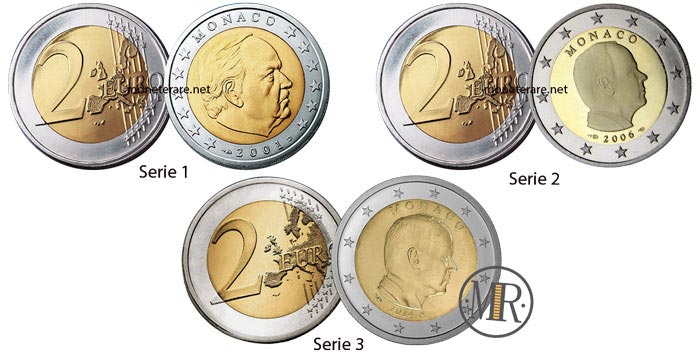
The latest coin in this collection is the 2 Euro Monaco coin. Once again, there is talk of a triple version. Specifically, the first one dates back to the years 2001 – 2005, the second one to 2006 and the third one to 2009.
The authors in this case are Nicolaz Cozon and Pierre Javaudin for the first and Sabrina Luoni for the second.
The first series of the coin depicts the bust of Prince Rainier III in the obverse. At the top there is the inscription Monaco while at the bottom the thousandth of minting followed by the symbol of Mint and that of the Director of Mint.
All around there are the 12 five-pointed stars, symbol of the European States.
As for the second and third series of the coin, however, there is the bust of Prince Albert II. Also in this case, at the top there is the inscription MONACO, while at the bottom there is the symbol of the Mint, a thousandth of minting and the symbol of the Director of the Mint.
All this is surrounded by the 12 five-pointed stars which are the symbol of the European States.
The reverse is the same for all 1 euro coins of all euro-area countries. Also in this case the First and Second versions propose the Common Face with the map of the countries with the borders well engraved. For the Third series instead is used the new version that represents the Euro Zone all united and without any graphic border between the different countries.
Let’s see now the technical specifications.
Specification of the 2 Euro Coin of Principality of Monaco
Materials: Also in this case we are talking about a double material. The external part is copper-nickel (copper 75% – nickel 25%) while the internal part is nickel-brass (copper 75% – zinc 20% – nickel 5%).
Thickness: The thickness decreases to 2.20 mm
Weight: Weight increases to 8.50 g
Diameter: The diameter is 25.75 mm
Outline: The contour is finely knurled with the incuso motif 2 followed by two stars alternating with the number. In particular, the number 2 is inserted alternately straight or inverted.
Engraver: Nicolas Cozon/Pierre Javaudin for the first and Sabrina Luoni for the second.
Value and Circulation of the 2 Euro Coin of Principality of Monaco
Among the 2 euros of the first series of the Principality of Monaco stand out the prices of the first three years, which are very high. The 2 euro Monaco 2002 and 2003 prices are approximately 13 euro each.
2 Euro Monaco 2001 Value
The 2001 Monaco 2 euro coin has a value of over 17 euro for collectors.
The second series includes the 2 euro coin of the most precious principality of Monaco, excluding the commemorative coins. This is the 2 euro Monaco 2006 coin quoted over 200 euro.
In the third and last series practically all the pieces have a higher value than the facial one. In particular, the 2€ Monaco euro coins of 2010 is worth almost 140 euro for collectors.
To sum up:
- The 2 euro Monaco for 2011 is quoted at 3.60 euro.
- The 2 euro Monaco of 2012 only 4.20 euro
- A 2 euro piece Monaco 2013 is worth over 55 euro
- A 2 euro Monaco coin from 2014 is worth only 3 euro.
- The 2 euro Monaco of 2015 is only 4 euro as well as the 2 euro Monaco of 2017 and 2018.
Do you want to learn more about Euro Coins?
- Two pages you can’t miss: 2 Euro Commemorative Coins and Rare Euro Coins
- The precious Vatican euro coins can be seen here and also the San Marino euro coins
- Here you can see the Malta euro coins and here the Cyprus euro coins.
- Euro coins from Germany can be found here and Euro coins from Estonia and Latvia Euro Coins here.
- Euro coins from France can be found here, as well as Euro coins from Austria.
- Also of great interest are the euro coins from Greece and the euro coins of Luxembourg.
- Here you will find Lithuania Euro coins and Andorra Euro coins
- We also talked about Slovenian Euro coins and Slovakia Euro coins.
- Check also Spanish Euro Coins here and Euro Coins of Portugal here.
- The Netherlands euro coins can be found here and the Ireland euro coins here.
- All precious Monaco Euro coins are here and Belgium Euro coins here



